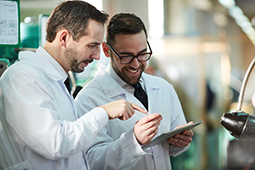A Technical Guide to Surface Preparation
To secure the strongest adhesive bond possible you will need a prepared surface, free from contamination. Why? Because adhesives adhere to surfaces and surfaces are often covered with dust, grease, oil, dirt, oxide films, rust inhibitors, and in the case of plastics mould release agents. All these contaminants, even at a microscopic level can interfere with the adhesive doing its job.
As a general rule, the more surface prep you do, the stronger and more durable a bond. Minimal surface preparation, such as wiping the area clean, might be fine for simple bonds. For structural strength bonds, more treatment is required. Always test first on samples to determine suitability.
Unfortunately there isn’t a ‘one size fits all’ solution to help get the best out of your adhesive, instead an array of surface preparation products and techniques are available which can be very confusing. Hopefully this guide will help you choose the right one.
Here are the types of surface preparation you can do, in order of greater effectiveness:
Standard Surface Cleaning
At a minimum, you need to have a CLEAN, dry surface on which to apply your adhesive. Remove as many surface contaminants as possible from the bond area, including dust, dirt, and grease. For delicate surfaces, clean off as much as practical, especially any loose particles or surface films. If you use detergents or liquids to clean the surface, make sure the surface is dry and void of trace cleaners before applying adhesive.
Chemical Cleaners and Degreasers
Cleaners and degreasers are designed to remove oils, greases, lubrication fluids, metal cuttings and fines from surfaces which are due to be bonded. They are highly effective in preparing surfaces for adhesive application. Common ones are solvents such as methyl ethyl ketone (MEK), acetone, or isopropyl alcohol. Wipe or bathe the surface clean.
- Silstrip is a solvent-free material which digests cured and uncured silicone and other polymers. It will have little effect on metal, glass, ceramic, rubber or painted surfaces making it a very useable choice!
- Pronatur Solvent is made from a blend of orange oils and mineral spirits, designed for safe cold water heavy duty cleaning. Pronatur will make light work of removing tar, grease, carbon, bitumen, waxes and certain adhesives. Like the Silstrip, Proanatur is very kind on lots of surfaces and will not damage metals, composite plastics, ceramics, concrete, stone glass, acrylic or wood. Available in a pourable containers or spray bottles.
Factors to consider when choosing a cleaner or degreaser;
- Does the drying time required fit in with your process?
- Is the substrate compatible? Substrate compatibility can become a concern when dealing with plastics and solvent-based cleaners.
- Does the cleaner or degreaser leave any residue? Can your application cope with any? When there is a secondary procedure taking place like bonding or painting; a residue could interfere with these additional processes.
- Always try a test area before full use!
Abrasion
Mechanical abrasion is one of the most commonly used surface preparation methods; suited to most materials this method aims to remove weak boundary layers. Abrasion will roughen the surface of the substrates and get rid of surface films, paint and oxides resulting in an increase in the bondable surface area whilst also enhancing the adhesives ability to fully wet the surface.
Fine grain sand paper, emery cloth, or steel wool can be used applied manually
Popular mechanical abrasion methods include:
Sandblasting
Use sandblasting with fine sand on substrates which are sufficiently thick to prevent distortion.
Vapour Honing
Use vapour honing when minimum reduction is desired in metal thickness.
After an abrasion treatment, remember to remove all loose particles before applying adhesive. Brush the surface or blow with compressed air, and then degrease to clear away all loose particles and residual oils. Abrading and degreasing is enough surface preparation for all but the most demanding industrial applications.
Surface Alteration
Some materials are simply difficult to bond. These include EPDM rubber, and "polyolefin" plastics (such as polyethylene, polypropylene, acetal, and hard nylon). Also, some metals such as copper, stainless steel, and aluminum are slightly more challenging to bond than other metals. If you are bonding these materials, you might need to change the surface properties to get good adhesion. Specifically, these are considered low surface energy surfaces, and you need to alter the surface to increase the surface energy. This involves using chemical primers, scorching the surface, grit blasting, or acid etching the surface. Because all materials are slightly different, consult your material supplier for the most effective way to treat the material for best adhesion.
Primers
Primers are designed to enhance the bonding quality of adhesives; they change the base of a surface to enable more effective adhesion. Primers are not always a necessity, requirement is based on the material being used and the substrate involved. Plastics generally require the use of a primer, and on some occasions the type of primer required for this material can be very specific. SS4179 is a good primer choice when working with silicones and plastics, however if you are working with cyanoacrylates and plastics Techsil® 77 would be a more suitable choice.
To increase adhesion when working with metals Techsil offers a range of solutions; SS4004p and SS4044 are condensation cure primers perfect for use with Silicone. Plexus™ PC120 will work perfectly when using an epoxy adhesive and Techsil® AP134-1 is the ideal choice for Polyurethanes. It’s also worth noting that AP134-1 doesn’t just help prepare the surface for metals, but also glass and masonry substrates.
Accelerators and Activators
Both accelerators and activators are applied before the adhesive to act as catalysts and are designed to reduced cure time and improve the quality of the adhesion. Activators are recommended over accelerators wherever possible; with accelerators there can be a trade off with the bond strength when this type of material is sued to speed up cure time.
Popular Activators:
- ThreeBond TB3095C - an activator designed for anaerobic adhesives that also benefits from offering very effective adhesion on metals, plastics and minerals. Normally used in thread locking and retaining applications.
- ThreeBond TB1796B – an activator designed for use with moisture cured cyanoacrylates, or instant adhesives. This grade enables porous surfaces to be bonded. Great for helping to bond wood and leather.

 If you would like to talk to us about your industrial application or production process, please call or message our technical experts:
If you would like to talk to us about your industrial application or production process, please call or message our technical experts: